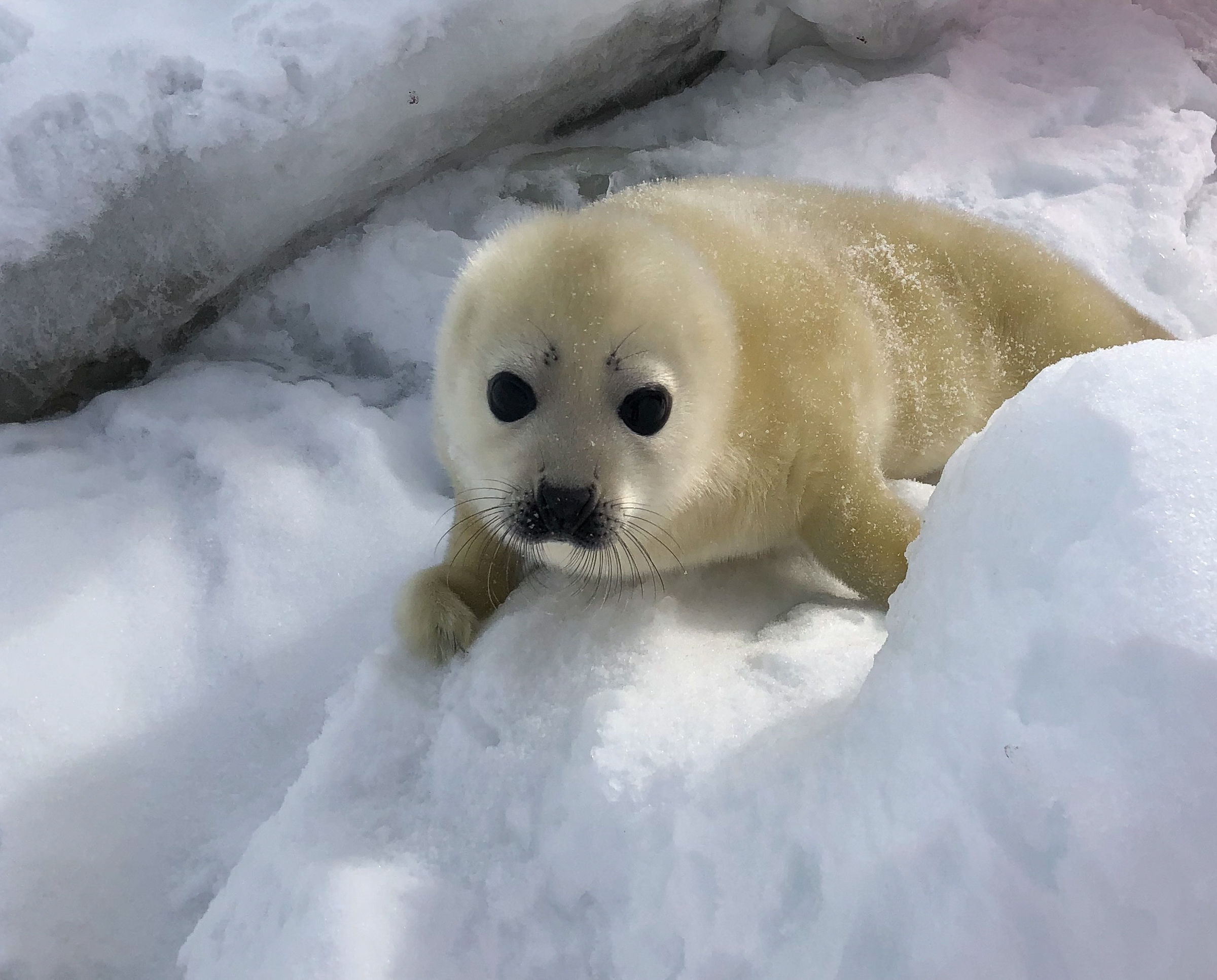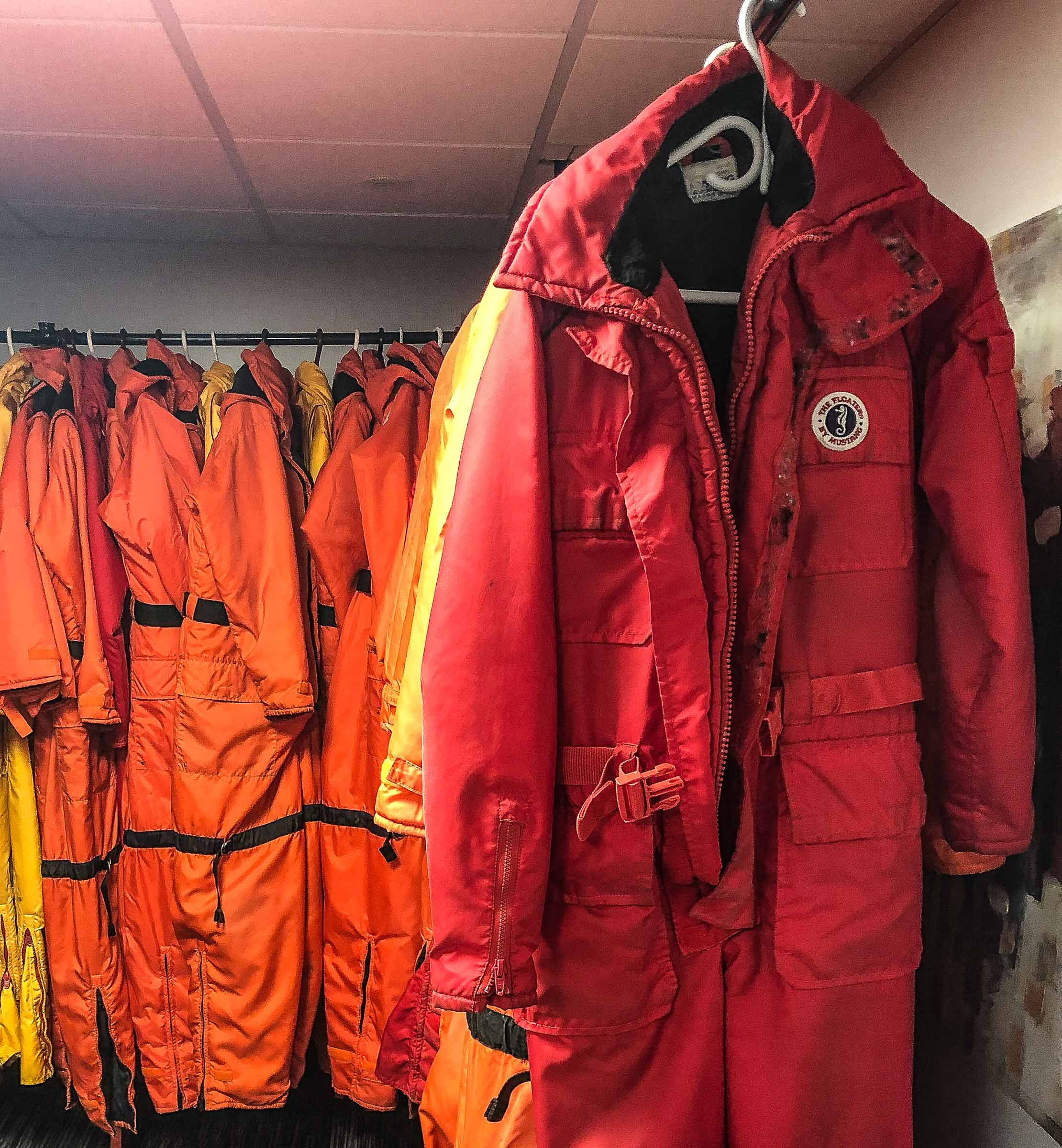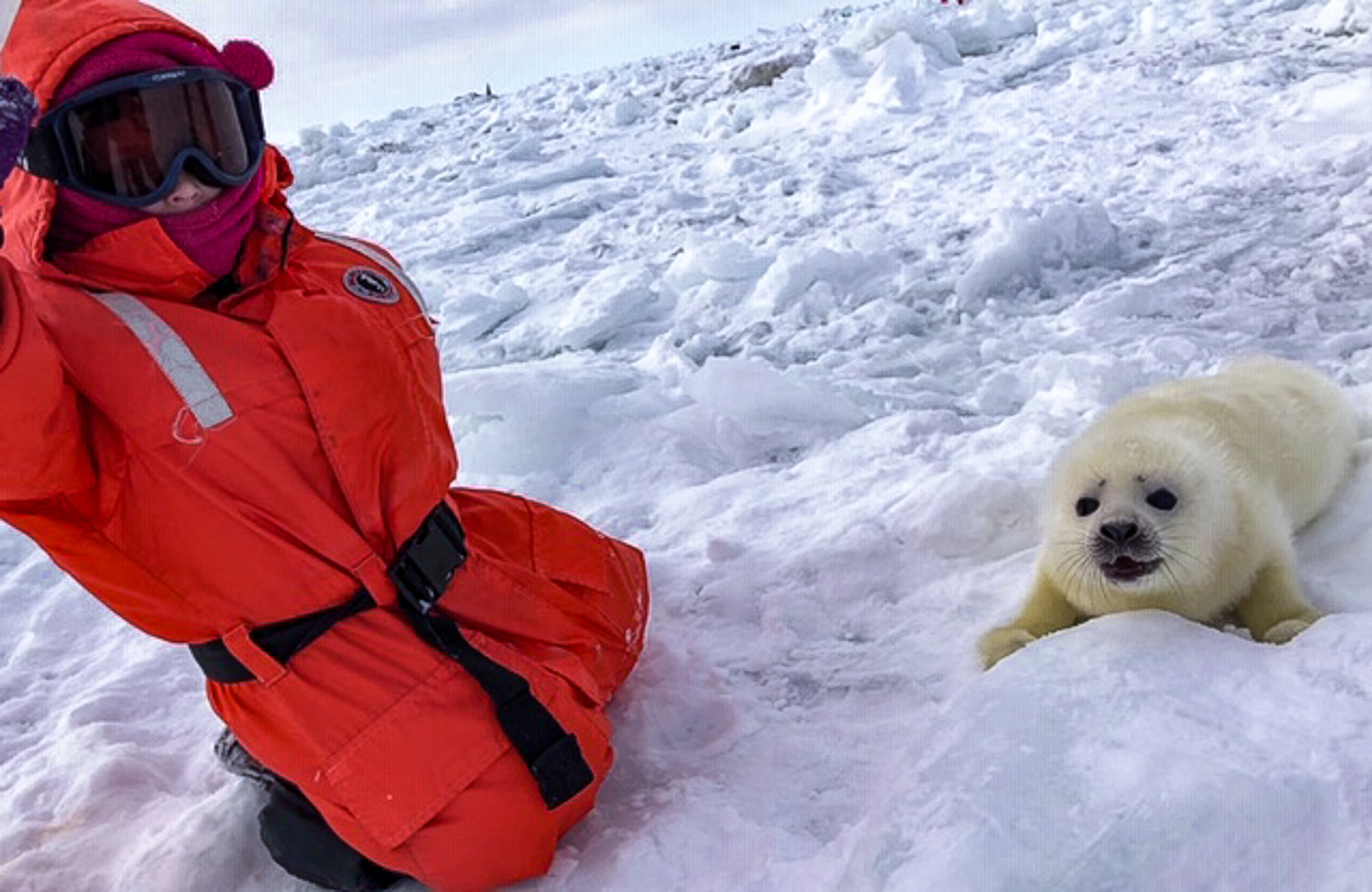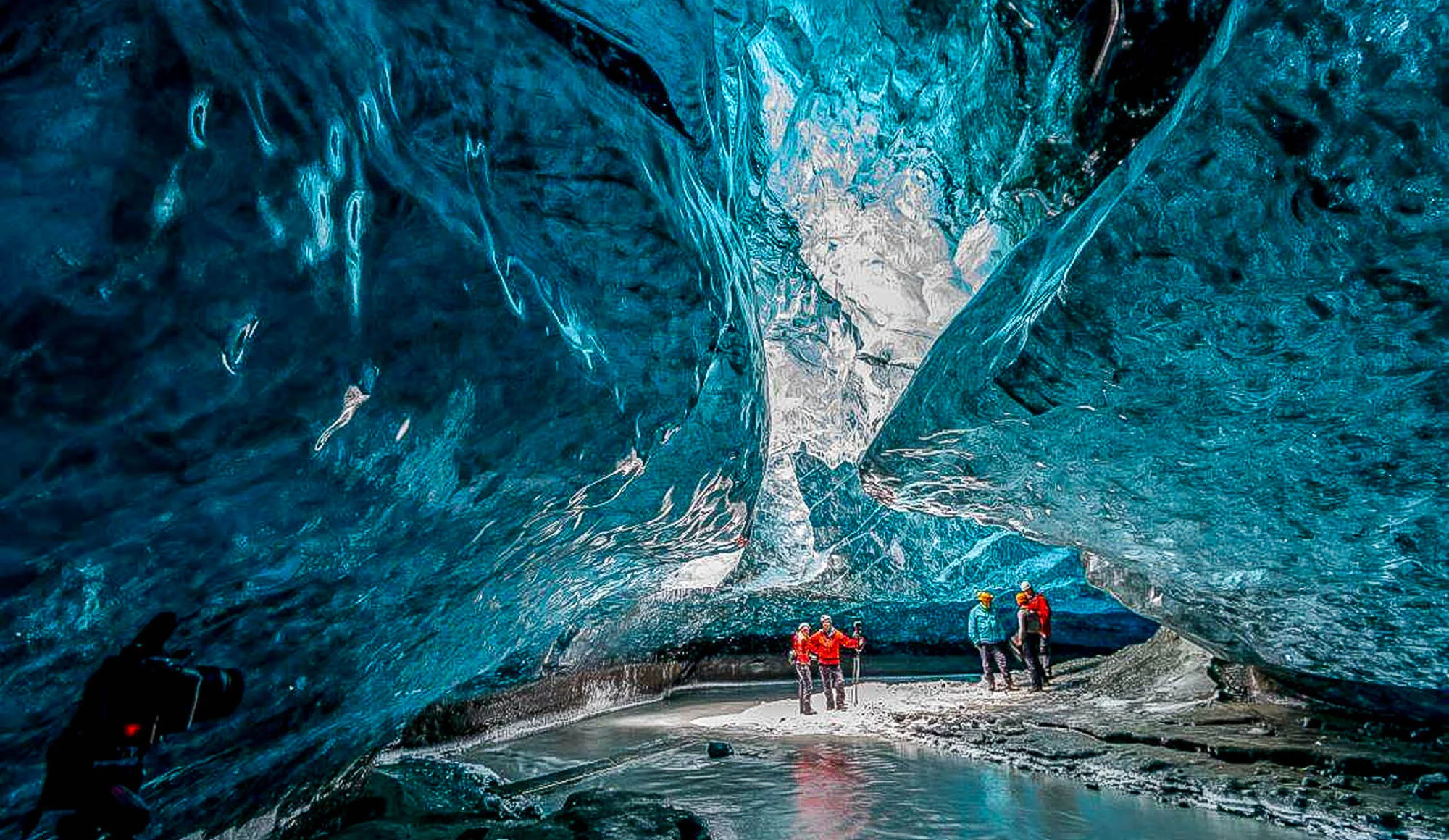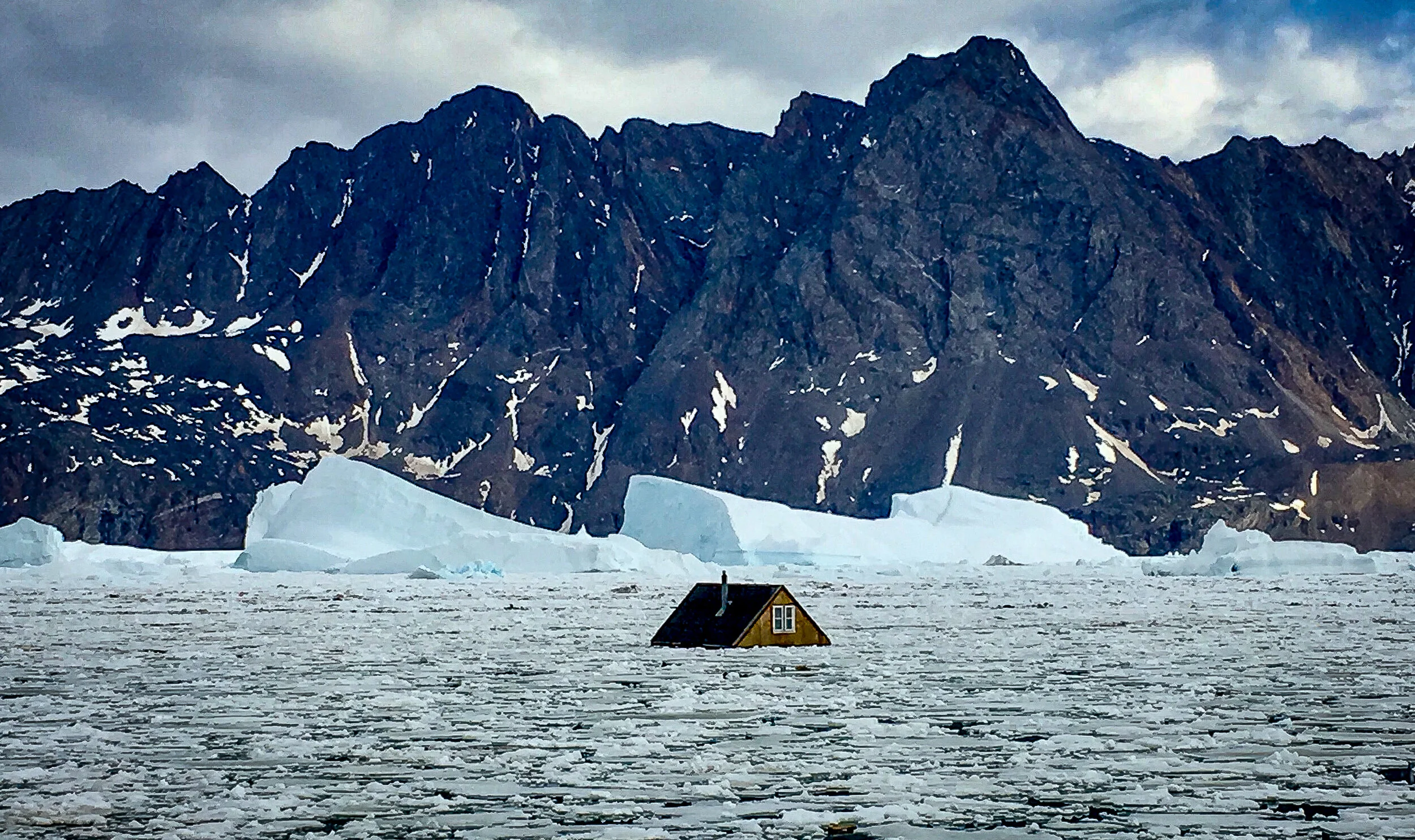Seal-Tourism: On Canadian Ice With The Baby Harps
ARCTIC TRAVEL / CANADA
Writer: Hugh Wilkinson
Photographs: Andrea King, Hugh Wilkinson
August 2019
A 125-kilogram mother harp seal streaks gracefully through the cold deep waters under the snow-covered pack ice while her just-born seal pup lounges on the ice above, calmly awaiting her return.
There are dozens of the yellowish white-pelted pups scattered across the immediate area not far from the 6-seater Bell helicopter from which we’ve just emerged. The mothers will occasionally come up to nurse and sleep. The pups look indistinguishable from each other, but the mothers identify them by smell.
Hugh Wilkinson writes about an unusual family vacation in the midst of winter, travelling to the Îles-de-la-Madeleine in Canada’s Gulf of St. Lawrence to meet up with new-born baby harp seals. An opportunity to gain insight into Arctic wildlife that is only possible within a three-week period each year.
A small group of us, dressed in orange ‘mustang flotation’ jump suits, tread slowly and quietly in sub-zero temperatures across the rugged frozen sea ice. We’re outfitted with ski poles for balance as we walk - and to test any dubious patches of ice as we’ve been warned about crevices, cracks and holes. We occasionally crouch down to get a closer look at the small baby seals (blanchons in French), their round white faces and dark eyes staring innocently back at us. There are blotches of blood and placenta on the ice from the mass birth, contrasting starkly against the white landscape. It is initially unsettling and from the air one might mistake the scene for a seal hunt.
We had flown 40 kilometers off the northwest shore of the archipelago of Les Îles-de-la-Madeleine (Magdalen Islands in English), situated in the middle of the Gulf of St. Lawrence in eastern Canada, a few hundred kilometers in from the Northwest Atlantic Ocean. Though closer in distance to the provinces of Nova Scotia, Prince Edward Island and Newfoundland and Labrador, the islands belong to the province of Québec.
It is late February and this part of the Gulf is frozen solid, notwithstanding occasional crevices; the locals call this lunar-like landscape ‘the ice cream’ owing to the wind-swept meringue-like pattern of frozen surface snow atop the half-meter thick ice pack.
Les Îles-de-la-Madeleine is one of the few places in the world that can accommodate seal-tourism. During that short winter season, helicopters dispatch for excursions several times a day from a beachfront in view of the island’s small community. JONAA©Andrea King
Harps seals come from afar to molt, pup and breed
Each year, for approximately 3 weeks in late February and early March, over a hundred thousand harp seals make their way from as far as Greenland, Baffin Island and other parts of the arctic and subarctic to congregate on the ice near the Îles-de-la-Madeleine to molt, pup and breed before migrating back north to summer feeding grounds. The babies are born very soon after the seals’ arrival, one to each mother.
It is typically a quick process, with a full birth taking only a few minutes and as little as 15 seconds. Within a few days the mothers - slipping through the natural cracks and holes in the sea ice - go underwater to breed with male harps who have accompanied them on the journey. The gestation will last almost a full year, when they will return thousands of kilometers to these same barren ice flows to give birth to another single pup.
Once on the ice, following an spectacular helicopter flight, one is in sheer awe of the presence of the animals, the stunningly vast panorama of sunshine, the cobalt blue sky and the bright white ice and snow. JONAA©Andrea King
One of the few places that can accommodate ‘seal-tourism’
Harp seals are extraordinarily migratory. The northwest population regularly moves up to 4,000 kilometers outside of the breeding season. Estimates as to the global population vary. According to Fisheries and Oceans Canada (a department of the federal government) the Northwest Atlantic harp seal population (2016) “is healthy and abundant with an estimated population of 7.4 million animals, almost six times what it was in the 1970s”.
While there are several other major harp seal birthing grounds (e.g.- one off the coast of Newfoundland and Labrador, a second on the "West Ice" off eastern Greenland, and another on the "East Ice" of the north coast of Russia in the White Sea) most are virtually inaccessible to humans, which makes Les Îles-de-la-Madeleine one of the few places in the world that can accommodate ‘seal-tourism’.
The sole group which operates these seal-watching trips in the Gulf is Château Madelinot, which for over 35 years has effectively served as a deluxe basecamp during the short seal-watching season. Accommodations at Château Madelinot are spacious and comfortable, the cuisine at the château’s Resto Bistro Accent is exquisite and sophisticated, and the Acadian hospitality is gracious and good-natured. Visitors come to see the seals from all over the world, but mostly from Japan, where the château has focused much of its marketing.
Perhaps in sync with the same migratory pull of the seals’ annual return, many tourists return frequently themselves. One such visitor – who has come virtually every year for several decades is the renowned Japanese wildlife photographer, Rei Ohara. He has been photographing the seals throughout his many visits and even produced a coffee-table book, ‘Ice Cradle: A Portrait of the Baby Harp Seal’ in 2005. The book is partly responsible for the high flow of seal watching tourists who come to Château Madelinot from Japan. Ohara gave a PowerPoint presentation one evening (in Japanese but the hotel provided translation) for all the guests highlighting his remarkable photographs and relating stories of his visits over the years.
Weaning is rather sudden; the mother turns from nursing to mating, leaving the pup behind on the ice. Within a few days after weaning, it sheds its white coat. JONAA©Andrea King
A destination for more than the three-week seal tourism season
The staff at the Château Madelinot, whether involved in the daily seal watching expeditions or not, were all exceptionally hospitable, helpful and engaging during our stay. For the inevitable down-time (even if one books multiple trips out onto the ice to watch the seals, there is still a lot of free time) the Château offers a wide range of outings and activities, including children’s crafts and games, with a new agenda posted daily.
Cindy Poirier spends much of her time organizing and leading other touristic activities for the guests. She grew up on the islands and has a shop, ‘Cindyhook’, in the summer offering windsurfing, kite-boarding and standup paddle-boarding camps and programs. Poirier has a gift in relaying the rich history of the islands in the form of stories and anecdotes. She accompanied a group of us on several outings, including ice-fishing one morning where we crowded into in a small hut with a Japanese family; we were unable to communicate but shared smiles, snacks and an occasional joke. We sampled cheese and other local fare, went bowling on a day where the wind was so strong everything else was closed, and witnessed a spectacular sunset one late afternoon at Corfu Beach.
There is much scenic beauty on the islands with its red cliffs, rolling hills and brightly coloured houses. For the hardy, there are other outdoor pursuits such as ice-sailing and fat-biking.
The locally owned Château Madelinot is bustling, even though it is mid-winter. We learn from the owner, Dany Leblanc that the hotel closes for several months before and after the baby harp seal watching season, and it is only the seals that enable any sort of tourism to the islands in the winter. All but a few other hotels, restaurants and stores on the islands are closed for the entire season. It is as if the islands have partially awoken, mid-hibernation.
In full view from the large picture windows of the château’s restaurant, the helicopters take off from the hotel’s beach front, two or three at a time, three times daily as weather permits. The season is very short, some days are too stormy or overcast to go out, and four out of the last ten years there were no trips at all because there was no ice. Ariane Bérubé, Château Madelinot’s sales director says, “we believe this increasing frequency of not having sufficient ice is an indication of the impact of climate change”. She mentions that the duration of the ice season has also been diminishing.
Les Îles-de-la-Madeleine is a popular summer destination but remote throughout winter. An integral part of the seal-watching trip is the sheer adventure of travelling there and back. High winds are almost a constant on the islands and in the winter, a combination of shifting ice conditions, blizzards and windstorms make this destination a challenge to reach and to return from.
Les Îles-de-la-Madeleine is a small archipelago in the Gulf of Saint Lawrence with a land area of 206 square kilometers. A ferry servicing the islands’ largest community, Cap-aux-Meules, from Souris, Prince Edward Island is the only means of entry by sea during the winter, during which it crosses back and forth just three times per week. One otherwise must fly in on indirect, relatively expensive, and weather-dependent flights from Quebec City and Montreal.
It was mid-February when we visited, harshly cold (as low as -30 Celsius some days) and our ferry, the Vacancier, plodded slowly behind a Canadian Coast Guard icebreaker. Numerous icebreakers roam the Gulf during much of the winter to enable transport of food, supplies and people to and from several especially remote Gulf of Saint Lawrence communities.
Trapped overnight in ice
The normal 5-hour crossing to Cap-aux-Meules took us 8 hours as the ferry frequently got bogged down in the broken-up ice and slush. We originally planned to stay 3 days on the islands but excessive ice and a high-wind storm, postponed our ferry’s return departure for three days. The additional days stranded on the islands permitted us to happily explore and discover numerous other enchanting sites, including an artisanal fromagerie, the old community of Havre-Aubert, beautiful dunes, a sand museum and beaches swept by sand and snow, ice fishing, and even a visit with a herd of ‘wapati’ (elk). The language of the islands is French and the culture is very much French-Acadian, including its distinctive music and hearty cuisine.
The return ferry to Prince Edward Island took a grueling 28 hours, owing to a slow pace through the thick pack ice and then getting fully trapped overnight in the middle of the Gulf. It was a nerve-wracking and sleepless night, hearing the deep groan of ice, metal and engines, as the small Soviet-era ship struggled to keep inching back and forth in order to avoid becoming solidly frozen in the ice.
Our icebreaker escort, named ‘Captain Molly Kool’, yielded to the darkness and hardening ice floe and gave up on us just after midnight. It returned in the early morning to resume efforts to break us from the grasp of the floating field of sea ice. The burly icebreaker alternated circling the old ferry and widening the path forward, its powerful hull crushing and plowing masses of ice until we could finally recommence our slow journey to land.
The nursing period is approximately 12 days long. JONAA©Andrea King
Neither nervous nor afraid of humans
The seal pups do not appear nervous or afraid of humans. Even though their immobility prevents them from withdrawing as we approach them, they do not seem outwardly defensive or anxious. Our guide explains that even unless they’re laying right beside them, the mothers really don’t mind if we pet the babies but it is nonetheless discouraged.
Co-mingling with these freshly born cuddly-looking animals in such a bitterly cold and remote wilderness environment brings a sudden sense of peaceful reverence upon us; even our two young children – normally quite easily excitable – were immediately rendered calm, no doubt by just the sheer awe and presence of these beautiful just-born animals, made all the more surreal by the stunningly vast panorama of sunshine, cobalt blue sky and bright white ice and snow.
The harp seal pups’ soft roundness and white-coated charm is enhanced by what often appears to be a friendly smile. This state of cuteness will not last long as baby harp seals grow up fast. Newborn pups weigh 11 kilograms (24 lbs.) on average at birth and are 80–85 centimeters (31–33 in.) long. The white fur of the newborns is tinted yellow from placental fluid. After a few days, the yellowish tint disappears, and the pups have a fluffy white fur coat (hence one of their nicknames, ’Whitecoats’). The nursing period is approximately 12 days long. The pups gain over 2.2 kilograms (4.9 lbs.) per day while nursing. During this time, the "greycoat" grows in beneath the white neonatal coat, and the pup increases its weight to as much as 36 kg (79 lbs.). The mothers’ milk is comprised of 25% pure fat. Soon the pups will have enough of their own blubber to survive for many days without any feeding at all.
Weaning is rather sudden; the mother turns from nursing to mating, leaving the pup behind on the ice. Within a few days after weaning, it sheds its white coat. In the post-weaning phase, the pup becomes sedentary to conserve body fat. The pups go without food for about six weeks, relying first on stored energy in the body core and can lose about half their body weight until they dive in and begin to hunt for themselves. Harp seals can live over 30 years in the wild.
It is particularly phenomenal that the relative swiftness of their birth and development has much to do with an almost preternatural and evolutionary awareness that the ice does not last long and will begin to melt in a matter of weeks or even days.
Co-mingling with these freshly born cuddly-looking animals in such a bitterly cold and remote wilderness environment brought a sudden sense of peaceful reverence upon us; even our two young children. JONAA©Andrea King
JONAA©Hugh Wilkinson
Many of the pups will not survive
Out on the sea ice, the vast white landscape seems to extend forever. It is as if one were strolling on another planet, where its only denizens are a plethora of yellow-tinted whitecoat babies and their large gray-coated mothers lazing against each other amidst craggy snow-drifted boulders of ice.
Many of the pups will not survive due to the harsh conditions, predators, or poor timing of the ice-melt. It is wildlife nature, at once wonderous and beautiful, exemplifying the instance of birth, migration and survival of a mammal which, although populous and currently not endangered, faces increasingly unpredictable sea ice conditions and higher mortality due to climate change.
We left these wind-swept islands feeling nourished by the nature, grateful for the adventure, and delighted by the spirit of the seals, the local people and our fellow travelers. The Îles-de-la-Madeleine and the Château Madelinot earned our admiration and praises, but the baby harp seals won our hearts. ▢
Raised in Canada, Hugh Wilkinson is an avid skier, hockey player and winter enthusiast. By trade he’s a global development aid consultant who has worked in 35+ countries. An occasional contributor to Maine Magazine, he now joins the editorial team of JONAA with this first article on seal-tourism. Wilkinson resides in St. John’s, Newfoundland & Labrador


